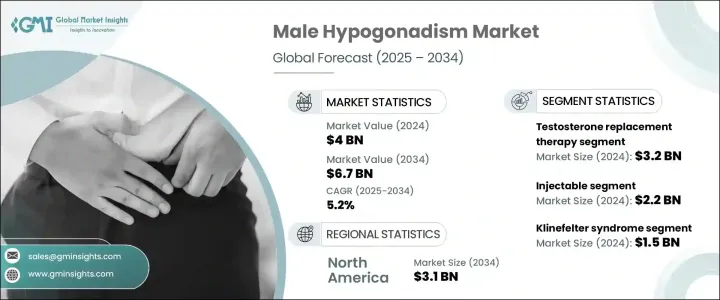PUBLISHER: Global Market Insights Inc. | PRODUCT CODE: 1698248

PUBLISHER: Global Market Insights Inc. | PRODUCT CODE: 1698248
Male Hypogonadism Market Opportunity, Growth Drivers, Industry Trend Analysis, and Forecast 2025-2034
The Global Male Hypogonadism Market was valued at USD 4 billion in 2024 and is projected to grow at a CAGR of 5.2% from 2025 to 2034. The growth is driven by increasing awareness of hormonal imbalances, advancements in diagnostic capabilities, and the rising prevalence of testosterone deficiency. This condition occurs when the body fails to produce adequate testosterone or when the testes do not function properly, leading to significant physical, sexual, and psychological complications. Since testosterone plays a crucial role in numerous male physiological functions, its deficiency can negatively impact overall health, energy levels, and quality of life.

A key factor fueling this growth is the increasing number of aging men experiencing hormonal changes that require medical intervention. Additionally, improved healthcare infrastructure and supportive regulatory frameworks are making advanced therapies more accessible. Ongoing research and development efforts are enhancing treatment efficacy, ensuring better patient outcomes and long-term adherence to prescribed therapies. Healthcare providers are increasingly focusing on innovative solutions to manage testosterone deficiency, leading to a surge in treatment adoption worldwide.
| Market Scope | |
|---|---|
| Start Year | 2024 |
| Forecast Year | 2025-2034 |
| Start Value | $4 Billion |
| Forecast Value | $6.7 Billion |
| CAGR | 5.2% |
Testosterone replacement therapy remains the dominant treatment approach, generating USD 3.2 billion in revenue in 2024. This segment is expected to expand at a CAGR of 5.3% through 2034, supported by the growing acceptance of hormone therapy and easier access to treatment options. Testosterone replacement helps restore normal hormone levels, improving sexual function, muscle mass, mood, and overall well-being. The availability of different administration routes, including injectables, topical gels, and oral formulations, ensures that patients can choose a treatment that aligns with their lifestyle and medical needs. Favorable reimbursement policies and insurance coverage have also played a pivotal role in driving market expansion, encouraging pharmaceutical companies to invest in research and innovation.
Based on the route of administration, the market is segmented into injectable, topical, and oral therapies. Injectable testosterone therapies accounted for a 55.3% market share, reaching USD 2.2 billion in 2024. These treatments are widely preferred for their ability to maintain stable hormone levels, preventing fluctuations that could cause mood swings, fatigue, and libido issues. Physicians favor injectable formulations due to their precision in dosage adjustments, allowing for personalized treatment plans that optimize hormone levels while minimizing potential side effects. As a result, patient adherence to these therapies remains high, further strengthening market growth.
North America continues to be a leading regional market, generating USD 1.8 billion in revenue in 2024 and expected to reach USD 3.1 billion by 2034. The U.S. accounted for the largest share, contributing USD 1.6 billion in 2023. The rising number of aging men dealing with hormonal deficiencies is a major driver of market demand in this region. Strict regulatory standards ensure the availability of high-quality, safe, and effective therapies. Additionally, growing awareness campaigns, increased healthcare spending, and advancements in medical research are supporting market expansion. As healthcare providers prioritize patient-centric treatment approaches, innovative therapies and stringent quality control measures will continue to shape the market landscape, ensuring improved outcomes for individuals affected by testosterone deficiency.
Table of Contents
Chapter 1 Methodology and Scope
- 1.1 Market scope and definitions
- 1.2 Research design
- 1.2.1 Research approach
- 1.2.2 Data collection methods
- 1.3 Base estimates and calculations
- 1.3.1 Base year calculation
- 1.3.2 Key trends for market estimation
- 1.4 Forecast model
- 1.5 Primary research and validation
- 1.5.1 Primary sources
- 1.5.2 Data mining sources
Chapter 2 Executive Summary
- 2.1 Industry 360° synopsis
Chapter 3 Industry Insights
- 3.1 Industry ecosystem analysis
- 3.2 Industry impact forces
- 3.2.1 Growth drivers
- 3.2.1.1 Increasing awareness and diagnosis
- 3.2.1.2 Rising incidence of hypogonadism
- 3.2.1.3 Advancements in testosterone replacement therapies
- 3.2.1.4 Growth in men’s health and wellness programs
- 3.2.2 Industry pitfalls and challenges
- 3.2.2.1 Safety concerns and side effects
- 3.2.2.2 Stringent regulatory compliance
- 3.2.1 Growth drivers
- 3.3 Growth potential analysis
- 3.4 Regulatory landscape
- 3.5 Pipeline analysis
- 3.6 Gap analysis
- 3.7 Patent analysis
- 3.8 Porter’s analysis
- 3.9 PESTEL analysis
Chapter 4 Competitive Landscape, 2024
- 4.1 Introduction
- 4.2 Company market share analysis
- 4.3 Company matrix analysis
- 4.4 Competitive analysis of major market players
- 4.5 Competitive positioning matrix
- 4.6 Strategy dashboard
Chapter 5 Market Estimates and Forecast, By Treatment Type, 2021 – 2034 ($ Mn)
- 5.1 Key trends
- 5.2 Testosterone replacement therapy
- 5.3 Gonadotropin therapy
Chapter 6 Market Estimates and Forecast, By Route of Administration, 2021 – 2034 ($ Mn)
- 6.1 Key trends
- 6.2 Injectable
- 6.3 Topical
- 6.4 Oral
Chapter 7 Market Estimates and Forecast, By Application, 2021 – 2034 ($ Mn)
- 7.1 Key trends
- 7.2 Kallmann syndrome
- 7.3 Klinefelter syndrome
- 7.4 Pituitary disorders
- 7.5 Other applications
Chapter 8 Market Estimates and Forecast, By Region, 2021 – 2034 ($ Mn)
- 8.1 Key trends
- 8.2 North America
- 8.2.1 U.S.
- 8.2.2 Canada
- 8.3 Europe
- 8.3.1 Germany
- 8.3.2 UK
- 8.3.3 France
- 8.3.4 Spain
- 8.3.5 Italy
- 8.3.6 Netherlands
- 8.4 Asia Pacific
- 8.4.1 China
- 8.4.2 Japan
- 8.4.3 India
- 8.4.4 Australia
- 8.4.5 South Korea
- 8.5 Latin America
- 8.5.1 Brazil
- 8.5.2 Mexico
- 8.5.3 Argentina
- 8.6 Middle East and Africa
- 8.6.1 South Africa
- 8.6.2 Saudi Arabia
- 8.6.3 UAE
Chapter 9 Company Profiles
- 9.1 AbbVie
- 9.2 Bayer
- 9.3 Eli Lilly and Company
- 9.4 Endo Pharmaceuticals
- 9.5 Ferring Holdings
- 9.6 Perrigo Company
- 9.7 Pfizer
- 9.8 Sanofi
- 9.9 Teva Pharmaceutical Industries
- 9.10 Viatris




